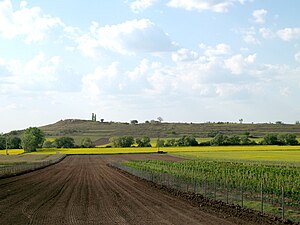Threshold castle
| Threshold castle | ||
|---|---|---|
|
South side of the nature reserve threshold castle |
||
| height | 227.4 m above sea level HN | |
| location | Thuringia ( Germany ) | |
| Coordinates | 51 ° 1 '50 " N , 10 ° 57' 15" E | |
|
|
||
| rock | Zechstein via Rotliegend | |
| particularities | Nature reserve | |
The threshold castle is a hill northwest of Erfurt , which has been under nature protection since 1939. The nature reserve covers an area of 22.5 hectares.
Located directly on federal highway 4 , the hill is the most striking and largest of several Härtlingen east of the Fahner Höhe . Its dimensions are about 1,200 meters by 500 meters, it rises about 50 meters above the surrounding fields and about 70 meters above the Gera floodplains at a maximum height of 227.4 meters above sea level. The threshold castle consists of keuper gypsum , which was dismantled there from 1865 for a lime distillery at the foot of the threshold castle .
There is no evidence that a castle or other fortifications were located there at any point in time to which the name could be traced back. Finds, however, indicated the existence of a Stone Age hilltop settlement and its use as a refuge in prehistoric times.
The terraced steps (“thresholds”) on the slopes, a relic of gypsum mining, are characteristic. The threshold castle was used for viticulture from the Middle Ages until 1935. At the highest point the gypsum rocks emerge and several small caves can be seen. The threshold castle is located in an area with little rainfall, and the karst subsoil hardly stores any water. The south side in particular is therefore subject to severe desiccation and soil warming. As a result of this and the earlier economic use, steppe vegetation flourishes there, as well as on some other ridges of the Thuringian Basin , which is untypical for Central Europe, which has attracted the attention of botanical research since the 19th century. However, some rare species found in early explorations have disappeared due to overexploitation as pasture. Different forms of xerothermal lawns with different associations, depending on the location, such as fescue-feathergrass dry lawn (Festuca-Stipetum) or germander- feathergrass dry lawn (Teucrio-Stipetum) are characteristic for the plant cover. The threshold castle is also remarkable from a zoological point of view. For example, within Germany only a small population of the rare species of cicada Praganus hofferi is known from there.
Since a few residential areas belonging to the city of Erfurt have emerged in the vicinity, the threshold castle has become a popular local excursion destination, with associated problems such as foot damage by visitors or the entry of nitrates along the paths, which led to the settlement of nitrophil species. Damage caused by driving on motorcycles has also been recorded.
literature
- Collective of authors: Manual of the nature reserves of the German Democratic Republic, Volume 4 . 2nd Edition. Urania-Verlag, 1984.
- Hans Schiemenz, 1969. The cicada fauna of Central European dry grasslands . Entomological treatises Staatliches Museum für Tierkunde in Dresden 36: 201–280.
Web links
- Private homepage with details on the flora and fauna of the threshold castle
- Nature conservation project area 9 "Dry grassland northwest of Erfurt"
Individual evidence
- ↑ Nature reserves in Thuringia: Erfurt - threshold castle. Thuringian State Institute for Environment and Geology (TLUG), 2009, accessed on April 14, 2011 : "The south-easternmost and at the same time most striking elevation in a series of gypsum keuper hills is the NSG 45" threshold castle ". This gypsum hill is characterized by species-rich, continental xerothermal lawns with representatives such as steppe pansy (the only German site) and steppe vetch as well as warmth-loving ruderal vegetation ... In addition, the area is also extremely valuable lichenologically. "



